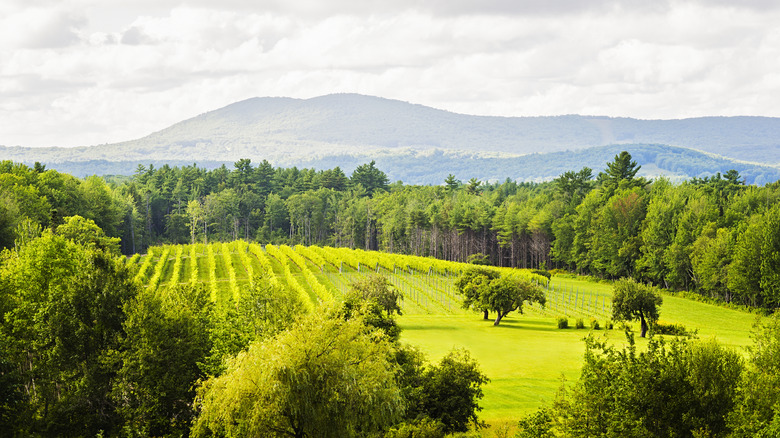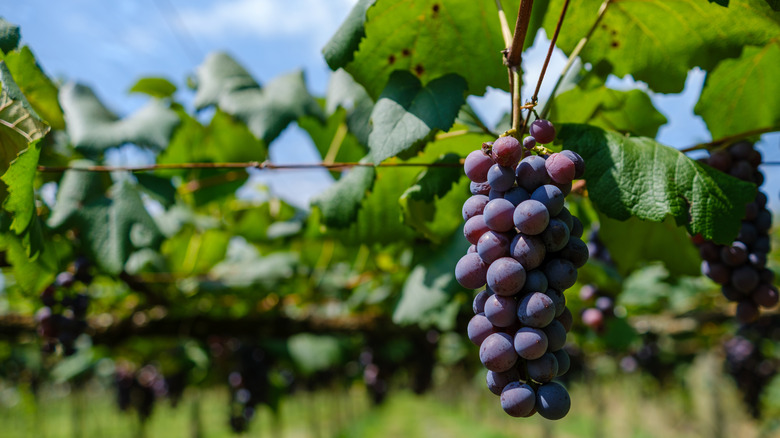The First State To Ever Impose Prohibition Is An East Coast Haven With A Burgeoning, Unique Wine Scene
Prohibition must have been a terrible time. First, activists successfully abolished "the tyranny of drink" in 1920. Then, the Great Depression hit nine years later in 1929 to make things truly depressing. Of course, people didn't stop drinking. They just went underground — literally. As a result, we were granted romantic visions of speakeasies and the precursor to our modern, creative cocktail culture, evident in fantastical bars like Costa Mesa, California's boba-and-cocktail Elixir Tea Craft. And now, the very first state in the United States to ban alcohol has become a rising hotspot amongst the East Coast's wine scene: Maine.
Maine was actually ahead of the curve when it came to banning alcohol. Long before Prohibition hit the United States en masse in the early 20th century, Mainiacs (as they sometimes call themselves) did the unthinkable and banned the sale of alcohol way back in 1851, except for "medicinal, mechanical, and manufacturing purposes," as the Portland Press-Herald writes. A mere four years later 3,000 rioters marched on Portland city hall demanding booze. The next year, in 1856, Maine's brief experiment with Prohibition was over.
This is why it's ironic and interesting that Maine has such a growing wine scene. The extensive Maine Wine Trail consists of 29 stops across the state that cover all stages of the wine-making process. This wine trail, and Maine's wine scene in general, highlights the state's unique approach to making wine, which uses hybrid grapes suitable for growing in Maine's otherwise non-grape-friendly climate.
Highlights of the tourist-focused Maine Wine Trail
Without a doubt, the easiest and most thorough way to tackle Maine's expanding wine scene is via the Maine Wine Trail. Imagine hitting the road through ruggedly beautiful, forested terrain, maybe stopping off a quaint little town like Millinocket for a little hiking, ducking into wineries for some responsible tastings here and there, and you've got a good idea of what to expect from the Maine Wine Trail. You could even interweave the wine trail with Maine's coastal "lobster crawl" to chow down on seafood along the way.
Contrary to its history as the first state to try its hand at Prohibition, Maine's tourism bureau is fully embracing its red, white, and rosé present. The Maine Winery Guild has an interactive map of all 29 wine trail-participating wineries where you can filter for tasting rooms, tours, food availability, and pet friendliness, and build your own cross-state itinerary that links to Google Maps. There's even a checklist feature like a stamp card where you can earn free swag like T-shirts and the chance to earn gift certificates and other prizes.
As far as specific wineries are concerned, some come highly recommended on sites like TripAdvisor. Cellardoor Winery in Lincolnville right near the middle of Maine's coast comes equipped not only tours of their 5.5-acre vineyard and tastings of an array of wines, reds, and dessert wines but also a cool backstory about a "hobo" who carved a symbol into their barn door that exists to this day. Prospect Hill Vineyard, meanwhile, has a very homey, guest-focused feel about the place and openly advertises their availability to host weddings. Folks looking to experience Maine's wine scene can browse and build whatever itinerary suits them best.
Maine's hybrid grapes grant its wine unique flavors
If there are so many nice wineries in Maine, and such a robust attempt on the part of the former first Prohibition state to promote the wine trail, what is it about Maine wine that's so special? After all, there are loads of lesser-known, but reputedly amazing pockets of wineries around the U.S., like Livermore Valley near San Francisco near coastal Californian mountains. As it turns out, Maine wines are unique in part because of the same reason that you'd never think of Maine as a good place to grow grapes. Maine's annual average temperature is 45.65 degrees Fahrenheit, which is a far cry from the optimal vine growth temperature of 77 to 90 degrees.
But, it's this grape-hostile climate that forced Maine vintners to develop inventive wine-production methods, starting with the grapes themselves. Maine wineries have taken to using what's called hybrid grapes over the past 10 to 15 years, which are European-American cross-bred grapes well-suited to surviving cold temperatures and damp environments. They were developed following a late-1800s blight of phylloxera — a type of louse — that nearly wiped out French vineyards.
This very region-specific, hybrid grape wine production makes Maine wines unique and grants them unique flavors. There's Chardonel instead of Chardonnay, for instance, a high acidity, medium body wine featuring an odd flavor combination that includes pear, lemon, coconut, and toast. Chambourcin, a red wine, is also unusual. It resembles Mediterranean wines but has more tannins, is also high in acidity, and has notes of black pepper, chocolate, and even herbs. In other words, visiting Maine wineries is like relearning everything you know about wine profiles. It's a fun coastal adventure, to boot.


